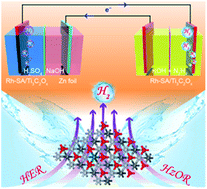Self-driven dual hydrogen production system based on a bifunctional single-atomic Rh catalyst†
Abstract
Electrocatalytic hydrogen evolution is an efficient and economical technology to address environmental contamination and energy crises, but the development of such a high-efficiency and energy-saving sustainable hydrogen production system remains a great challenge. Here, we present a novel strategy to design a self-driven dual hydrogen production system for efficient hydrogen production based on highly-dispersed single Rh atoms supported on an oxygen-functionalized Ti3C2Ox MXene (Rh-SA/Ti3C2Ox) catalyst. The bifunctional Rh-SA/Ti3C2Ox catalyst exhibits remarkable catalytic activities towards both the pH-universal hydrogen evolution reaction (HER) and hydrazine oxidation reaction (HzOR). Using Rh-SA/Ti3C2Ox as the electrode in the self-driven dual hydrogen production system by combining a Zn–H2 battery and overall hydrazine splitting units, an ultra-high H2 generation rate of 45.77 mmol h−1 can be achieved. Density functional theory calculations indicate that the atomically dispersed single Rh atoms not only make the free energy of adsorbed H (ΔG*H) more thermoneutral for the HER but also largely decrease the free-energy barrier of the dehydrogenation of adsorbed NHNH2 for the HzOR.

- This article is part of the themed collections: 2023 Journal of Materials Chemistry A Lunar New Year collection and Single-Atom Catalysis


 Please wait while we load your content...
Please wait while we load your content...